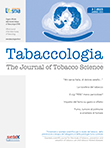|
Rassegna Stampa Scientifica Dicembre 2021
Association of E-Cigarettes With Erectile Dysfunction: The Population Assessment of Tobacco and Health Study American Journal of Preventive Medicine Published: November 30, 2021 Omar El-Shahawy, Tanmik Shah, Olufunmilayo H. Obisesan, Meghan Durr, Andrew C. Stokes, Iftekhar Uddin, Ria Pinjani, Emelia J. Benjamin, Mohammadhassan Mirbolouk, Albert D. Osei, Tom Loney, Scott E. Sherman, Michael J. Blaha https://www.ajpmonline.org/article/S0749-3797(21)00429-3/fulltext https://www.ajpmonline.org/action/showPdf?pii=S0749-3797%2821%2900429-3
Note: Open Access.
Related coverage:
E-cigarettes may be independently linked to erectile dysfunction, new research finds Men who vape are twice as likely to have erectile dysfunction: study https://nypost.com/2021/12/01/men-who-vape-are-twice-as-likely-to-have-erectile-dysfunction-study/ Men who use e-cigarettes are more than twice as likely to suffer erectile dysfunction than non-smokers, study finds
"Soon after FDA’s [Food & Drug Administration's] January 2020 announcement of prioritized enforcement against flavored pod/cartridge-based e-cigarettes and during the pandemic lockdown, adolescents’ and young adults’ past 30-day use included mostly flavored disposables rather than pod/cartridge-based e-cigarettes, mint/menthol flavors, and some used add-on flavor enhancers. To reduce youth use, comprehensive regulation of e-cigarette devices and flavors should be enacted and enforced at federal, state, and local levels."
E-cigarette devices, brands, and flavors attract youth: Informing FDA's policies and priorities to close critical gaps Addictive Behaviors Volume 126, March 2022, 107179 Available online 14 November 2021. Shivani Mathur Gaiha, Lauren Kass Lempert, Karma McKelvey, Bonnie Halpern-Felsher https://www.sciencedirect.com/science/article/abs/pii/S0306460321003646
Related PR:
Whack-a-mole vaping policies do not protect youth, Stanford Medicine study shows https://med.stanford.edu/news/all-news/2021/11/vaping-products-young-people.html
"This investigation highlighted that, unhealthy behaviors, particularly e-cigarette use, cigarette smoking, and excessive use of screens, tend to co-occur among Canadian adolescents. Therefore, intervention strategies to promote healthy lifestyles should take a holistic approach, by targeting multiple behavioral changes simultaneously particularly in school and community settings. As an exception, new and stable e-cigarette use appears to co-occur with achieving sufficient levels of physical activity. Increasing awareness about the risk of e-cigarette use may target population groups that are physically and socially active (e.g., athletes, sport teams)."
Longitudinal associations between e-cigarette use, cigarette smoking, physical activity and recreational screen time in Canadian adolescents Nicotine & Tobacco Research, ntab248. Published: 28 November 2021 Dylan S Irvine, Ellen McGarity-Shipley, Eun-Young Lee, Ian Janssen, Scott T Leatherdale https://academic.oup.com/ntr/advance-article-abstract/doi/10.1093/ntr/ntab248/6445184
Also:
Trajectories of Nicotine Use Leading to Dual and Cyclical Tobacco Product Use in Young Adults https://academic.oup.com/ntr/advance-article-abstract/doi/10.1093/ntr/ntab249/6446209
"Over half (53.6%) of students were exclusive e-cigarette users, 20.4% were dual e-cigarette and combustible cigarette users, 4.6% were dual e-cigarette and cigar users, and 21.4% were poly users of e-cigarettes, combustible cigarettes, and cigars. Compared to exclusive e-cigarette users, dual users of e-cigarettes and combustible cigarettes (AOR=2.12, 95%CI=1.05–4.27) and poly users of e-cigarettes, combustible cigarettes, and cigars (AOR=3.70, 95%CI=1.78–7.70) had increased odds of COVID-19 symptomatology, even when accounting for covariates."
Assessment of Exclusive, Dual, and Polytobacco E-Cigarette Use and COVID-19 Outcomes Among College Students Am J Health Promot. 2021 Dec 6;8901171211055904. Online ahead of print. Ashley L Merianos, Alex M Russell, E Melinda Mahabee-Gittens, Adam E Barry, Meng Yang, Hsien-Chang Lin https://journals.sagepub.com/doi/10.1177/08901171211055904
"In our opinion, the current evidence suggests it is critical that physicians be aware of the effects of nicotine concentration and flavourants when prescribing e-liquids to Australian vapers. Prescribing physicians should combine e-cigarettes with structured behavioural support to promote tobacco cessation and, ideally, complete nicotine abstinence, rather than seeking to reduce patients’ nicotine intake through dual use of e-cigarettes and tobacco cigarettes. A starting level of nicotine should be chosen that is no higher than that in tobacco cigarettes, but which is sufficient to suppress nicotine cravings. The (perceived) benefits of inclusion of flavourants on smoking cessation must be balanced with their potential for toxicity and promotion of nicotine addiction."
Perspective What doctors should consider before prescribing e-liquids for e-cigarettes Medical Journal of Australia First published: 28 November 2021 Miranda P Ween, David G Chapman, Alexander N Larcombe https://onlinelibrary.wiley.com/doi/10.5694/mja2.51351
Related MJA Editorial:
E-liquids and vaping devices: public policy regarding their effects on young people and health https://onlinelibrary.wiley.com/doi/10.5694/mja2.51362
"This is a secondary data analysis of 2016-2018 data of the U.S. Pregnancy Risk Assessment Monitoring System… Rates of cessation during pregnancy were highest among exclusive e-cigarette users (weighted percentage 80.7% [49,378/61,173]), followed by exclusive cigarette users (54.4% [421,094/773,586]) and then dual users (46.4% [69,136/149,152). Among exclusive e-cigarette users, continued users of e-cigarettes during pregnancy had a higher risk of small-for-gestational-age than non-users (16.5% [1,849/11,206]) vs. 8.8% [384,338/4,371,664]; confounder-adjusted RR, 1.52 [95% confidence interval, 1.45-1.60]), whereas quitters of e-cigarettes had a similar risk of small-for-gestational-age to non-users (7.7% [3,730/48,587] vs. 8.8% [384,338/4,371,664]; RR, 0.84 [0.82-0.87])."
Changes in e-cigarette and cigarette use during pregnancy and their association with small-for-gestational-age birth Am J Obstet Gynecol. 2021 Dec 2;S0002-9378(21)02583-7. Online ahead of print. Abdal Aziz T Shittu, Brinda P Kumar, Ugonna Okafor, Sara Berkelhamer, Maciej L Goniewicz, Xiaozhong Wen https://www.ajog.org/article/S0002-9378(21)02583-7/pdf
"A 59-year-old female ex-smoker with 40 pack year smoking history and a 5-year current e-cigarette (EC) use history, presented with progressive dyspnea on exertion and daily cough for 2 months… Despite the recommendation of vaping cessation, the patient continued to use EC [e-cigarettes]. A new CT [Computed tomography] exam, carried out after 18 months, showed reversed halo sign (RHS), patchy ground-glass opacity (GGO), pleuro-parenchymal bands, and indeed perilobular pattern, suggestive of organizing pneumonia (OP). The final diagnosis was E-cigarette, or vaping, product use Associated Lung Injury (EVALI)- related OP."
E-cigarette, or vaping, product use Associated Lung Injury (EVALI): new scenarios for physicians and radiologists Monaldi Arch Chest Dis. 2021 Dec 3. Online ahead of print. Carmine Guarino, Ilaria Pedicelli, Francesco Perna, Valentina Di Spirito, Giuseppe Fiorentino, Fabio Procaccini, Gaetano Rea https://monaldi-archives.org/index.php/macd/article/view/1962 https://monaldi-archives.org/index.php/macd/article/view/1962/1372
Note: Open Access.
"Continuing declines in adolescent menthol prevalence indicate that both menthol prevalence and also black/non-black disparities in its use are steadily decreasing. However, these decreases in adolescence will take decades to reach later ages through generational replacement. Efforts to accelerate menthol decreases will require new initiatives to increase cessation among adult menthol users."
Recent, national trends in US adolescent use of menthol and non-menthol cigarettes Tobacco Control Published Online First: 01 December 2021. Richard A Miech, Adam M Leventhal, Lloyd D Johnson https://tobaccocontrol.bmj.com/content/early/2021/11/30/tobaccocontrol-2021-056970
Also:
Risk perceptions and continued smoking as a function of cigarette filter ventilation level among US youth and young adults who smoke https://tobaccocontrol.bmj.com/content/early/2021/12/01/tobaccocontrol-2021-056833
"Of 53 studies included, six were global, 32 from Asia, Middle East and Africa (AMEA), nine from USA and six from Europe. 'Poor'-rated studies predominated (23;43%), in particular, for global (4;66%) and AMEA (16;50%). Health outcomes differed between SLT-products and regions; those in AMEA were associated with higher mortality (overall, cancer, Coronary heart disease (CHD), respiratory but not cardiovascular disease (CVD)), and morbidity (CVD, oral and head and neck cancers), with odds ratios up to 38.7."
The health impact of smokeless tobacco products: a systematic review Harm Reduct J. 2021 Dec 4;18(1):123. C Hajat, E Stein, L Ramstrom, S Shantikumar R Polosa Funding This investigator initiated study was sponsored by ECLAT srl, a spin-off of the University of Catania, with the help of a grant from the Foundation for a Smoke-Free World Inc., a US nonprofit 501(c)(3) private foundation with a mission to end smoking in this generation. https://harmreductionjournal.biomedcentral.com/articles/10.1186/s12954-021-00557-6
Note: Open Access. Funding statement does not note that FSFW is entirely funded by Philip Morris International (PMI). See also lengthy Competing Interests statement.
"Our results suggest blood nicotine and nicotine content both predict behavioral economic demand abuse liability. In addition, our results suggest a nicotine content of 1.3mg/g or lower may be effective at reducing cigarette uptake among first-time (naïve) smokers. Our results largely conform to previous findings suggesting a very low nicotine content cigarette maintains lower abuse liability than full-strength cigarettes."
Blood Nicotine Predicts the Behavioral Economic Abuse Liability of Reduced-Nicotine Cigarettes Nicotine Tob Res. 2021 Dec 3;ntab227. Online ahead of print. Brent A Kaplan, Elisa M Crill, Christopher T Franck, Warren K Bickel, Mikhail N Koffarnus https://academic.oup.com/ntr/advance-article-abstract/doi/10.1093/ntr/ntab227/6448746
Also:
Preliminary evaluation of short-term abstinence effects among never-smoking experienced users of modern electronic cigarettes https://academic.oup.com/ntr/advance-article/doi/10.1093/ntr/ntab252/6453475
Note: Short-term abstinence paper Open Access.
"In England, small retailers’ support for the four point-of-sale tobacco control policies varied between 54-66%. Support seems unrelated to perceived importance of tobacco sales, and contact with the tobacco industry, but seems strongly related to the perceived impact of tobacco control policies on their business."
Tobacco retailers’ support for point-of-sale tobacco control policies in England: Association study of retailers’ perceived importance of tobacco sales, contact with the tobacco industry, and the perceived impact of the policy Nicotine & Tobacco Research, ntab244. Published: 30 November 2021 Tessa R D van Deelen, Deborah Arnott, Sara Hitchman, Bas van den Putte, Anton E Kunst, Mirte A G Kuipers https://academic.oup.com/ntr/advance-article-abstract/doi/10.1093/ntr/ntab244/6446860
"This study provides longitudinal evidence that among adult smokers, misperceiving nicotine as a primary cause of smoking-related diseases may be associated with reduced cessation success and lower likelihood of using less harmful nicotine products. These misperceptions may therefore impede efforts to encourage smokers ready to quit to use evidence-based cessation support such as nicotine replacement during quit attempts and limit the success of policies designed to shift smokers to less harmful sources of nicotine."
Associations Between Nicotine Knowledge and Smoking Cessation Behaviors among U.S. Adults Who Smoke Nicotine & Tobacco Research, ntab246. Published: 25 November 2021 L M Snell, S M Colby, T DeAtley, R Cassidy, J W Tidey https://academic.oup.com/ntr/advance-article-abstract/doi/10.1093/ntr/ntab246/6440299
Also:
Effect of Electronic Nicotine Delivery Systems on Cigarette Abstinence in Smokers with no Plans to Quit: Exploratory Analysis of a Randomized Placebo-Controlled Trial https://academic.oup.com/ntr/advance-article-abstract/doi/10.1093/ntr/ntab247/6444300 Smoking patterns among urban Alaska Native and American Indian adults: The Alaska EARTH 10-year follow-up study https://academic.oup.com/ntr/advance-article-abstract/doi/10.1093/ntr/ntab245/6440296
"We included 279 RCTs [randomized controlled trials] from 13 Cochrane reviews. Of all studies, 51 (18.3%) explicitly excluded participants with any MHDs [mental health disorders], 152 (54.5%) conditionally excluded based on certain MHD criteria and 76 (27.2%) provided insufficient information to ascertain either inclusion or exclusion. Studies of antidepressant medications used for smoking cessation were found to be 3.33 times more likely (95% CI 1.38 to 8.01, p=0.007) to conditionally exclude smokers with MHDs than explicitly exclude compared with studies of nicotine replacement therapy."
Inequity in smoking cessation clinical trials testing pharmacotherapies: exclusion of smokers with mental health disorders Tob Control. 2021 Dec 3;tobaccocontrol-2021-056843. Online ahead of print. Saki Rubaiya Talukder, Julia M Lappin, Veronica Boland, Hayden McRobbie, Ryan James Courtney https://tobaccocontrol.bmj.com/content/early/2021/12/02/tobaccocontrol-2021-056843
Also:
Variations in cigarette brand characteristics: can consumers tell the difference? https://tobaccocontrol.bmj.com/content/early/2021/11/28/tobaccocontrol-2021-056856
Note: Open Access.
"The continuous abstinence rate was significantly higher in the financial incentives group (16%, 38/231) than control group (7%, 17/229): odds ratio 2.45 (95% confidence interval 1.34 to 4.49), P=0.004). The point prevalence abstinence rate was higher (4.61, 1.41 to 15.01, P=0.011), the median time to relapse was longer (visit 5 (interquartile range 3-6) and visit 4 (3-6), P<0.001)), and craving for tobacco was lower (β=−1.81, 95% confidence interval −3.55 to −0.08, P=0.04) in the financial incentives group than control group… Conclusions: Financial incentives to reward smoking abstinence compared with no financial incentives were associated with an increased abstinence rate in pregnant smokers. Financial incentives dependent on smoking abstinence could be implemented as a safe and effective intervention to help pregnant smokers quit smoking."
Financial incentives for smoking cessation in pregnancy: multicentre randomised controlled trial BMJ 2021; 375 (Published 01 December 2021) Ivan Berlin, Noémi Berlin, Marie Malecot, Martine Breton, Florence Jusot, Léontine Goldzahl https://www.bmj.com/content/375/bmj-2021-065217 https://www.bmj.com/content/bmj/375/bmj-2021-065217.full.pdf
Related BMJ Editorial:
Incentives for smoking cessation in pregnancy https://www.bmj.com/content/375/bmj.n2889 https://www.bmj.com/content/bmj/375/bmj.n2889.full.pdf
Note: Open Access.
"882 849 patients registered with participating practices recorded as current smokers during 2007-2014…The majority (>70%) of smokers had recorded smoking cessation advice. This was consistently higher in those with SMI [severe mental illness] than the other cohorts of patients, although the gap greatly reduced in more recent years. Increases in smoking cessation advice over time were not accompanied by increases in recorded attempts to quit or changes of smoking status. Overall nicotine replacement therapy prescribing by general practitioners (GPs) was higher in those with SMI (10.1%) and depression (8.7%) than those without (5.9%), but a downward time trend was observed in all groups."
Time trends in access to smoking cessation support for people with depression or severe mental illness: a cohort study in English primary care BMJ Open. 2021 Dec 3;11(12):e048341. Milena Falcaro, David Osborn, Joseph Hayes, Gary Coyle, Lisa Couperthwaite, Scott Weich, Kate R Walters https://bmjopen.bmj.com/content/11/12/e048341
Note: Open Access.
"Findings indicated that as grades increased from “Best” to “Still Desirable” to “Definitely Declining” and “Hazardous,” retailer density increased monotonically. These results highlight the persisting impacts of redlining and how disparities, once intentionally created, can be perpetuated over time."
The legacy of redlining: Associations between historical neighborhood mapping and contemporary tobacco retailer density in Ohio Health & Place Volume 68, March 2021, 102529 Available online 22 February 2021. Elli Schwartz, Nathaniel Onnen, Peter F. Craigmile, Megan E. Roberts https://www.sciencedirect.com/science/article/abs/pii/S1353829221000253
Trends in Prevalence of Tobacco Use by Sex and Socioeconomic Status in 22 Sub-Saharan African Countries, 2003-2019 JAMA Netw Open. 2021;4(12):e2137820. December 8, 2021 Chandrashekhar T. Sreeramareddy, Kiran Acharya https://jamanetwork.com/journals/jamanetworkopen/fullarticle/2786937
Note: Open Access.
"People working in the field have long talked about tobacco as a social justice issue, but considerations of just what to do about addressing that have often been secondary to identifying and documenting the numerous disparities that persist between groups with social advantages and those without. In a sense, this is understandable: for some disadvantaged populations, it has been a real fight to simply become recognised and visible enough to have data systematically collected for research. For others, it has been a struggle to articulate within their own communities why tobacco has something to do with the overarching systemic injustices that permeate daily life. This issue [Tobacco and social justice, V30:e2] features a set of papers that speak broadly to the theme of tobacco and social justice, demonstrating how researchers are thinking about these issues in work that moves the field forward."
Editorial Justice, disparities and the tobacco endgame Tobacco Control 2021;30:e76-e77. Online issue publication December 08, 2021 Ruth E Malone https://tobaccocontrol.bmj.com/content/30/e2/e76 https://tobaccocontrol.bmj.com/content/tobaccocontrol/30/e2/e76.full.pdf
Note: Open Access.
"Among 7541 screening-eligible adults, current cigarette use was reported by 3604 (47.8%) participants. Ever and current e-cigarette use were reported by 3003 (39.8%) and 670 (8.9%) participants, respectively. Conclusions: Cigarette and e-cigarette exposure are common among U.S. adults who are eligible for lung cancer screening. Expanded USPSTF [United States Preventative Services Taskforce] criteria will capture a patient population with greater exposure to both of these products."
Prevalence of cigarette and e-cigarette use among U.S. adults eligible for lung cancer screening based on updated USPSTF guidelines Cancer Epidemiol. 2021 Dec 8;76:102079. Online ahead of print. Brendan T Heiden, Kathryn E Engelhardt, Chao Cao, Bryan F Meyers, Varun Puri, Yin Cao, Benjamin D Kozower https://www.sciencedirect.com/science/article/abs/pii/S187778212100196X
"Never-smoking ECIG users experience some aversive nicotine withdrawal symptoms within two to three hours of abstinence. Relative to ad lib ECIG use, abstinence decreased heart rate and inhibitory control, as well as increased subjective ratings of withdrawal such as craving and intention to vape. Those same symptoms might be suppressed by self-administration of ECIGs. Experiencing withdrawal upon abstinence may indicate that ECIGs can cause dependence without a history of other tobacco use."
Preliminary evaluation of short-term abstinence effects among never-smoking experienced users of modern electronic cigarettes Nicotine & Tobacco Research, ntab252. Published: 05 December 2021 Nicholas Felicione, Ashley Douglas, F Joseph McClernon, Melissa D Blank https://academic.oup.com/ntr/advance-article-abstract/doi/10.1093/ntr/ntab252/6453475
Also:
Blood Nicotine Predicts the Behavioral Economic Abuse Liability of Reduced-Nicotine Cigarettes https://academic.oup.com/ntr/advance-article-abstract/doi/10.1093/ntr/ntab227/6448746
"Secondary analysis of data from a longitudinal web-based survey of smokers, ex-smokers and vapers (n=3883) in the UK in 2019… Overall, 53.4% used TI [tobacco industry] products… TI products used were less likely to be refillable (‘open’) than independent brands (60.9% vs. 18.3%, chi-square=228.98, p<0.001), more likely to use nicotine salts (16.7% vs. 8.6%, chi-square=25.04, p<0.001) and tobacco flavours (23.8% vs. 17.9%, chi-square=12.65, p<0001)… Implications: Consequences of regulations need to be carefully considered to ensure that independent producers are not more negatively impacted than tobacco industry producers, and to avoid reducing utility of products for smoking cessation."
The use of tobacco industry vaping products in the UK and product characteristics: A cross-sectional survey Nicotine & Tobacco Research, ntab253. Published: 09 December 2021 Elliot J Cornish, Leonie S Brose, Ann McNeill https://academic.oup.com/ntr/advance-article/doi/10.1093/ntr/ntab253/6458313
Also:
Building a foundation for evidence-based decision-making on e-cigarettes https://academic.oup.com/ntr/advance-article/doi/10.1093/ntr/ntab254/6459586
Note: Open Access.
"Noticing warnings was higher among NVP [nicotine vaping product] users (18.8%) than non-users (2.1%). Noticing warnings was associated with perceiving nicotine to pose little or no harm to health among NVP users, but there was no association among non-users. There was little evidence of an association between noticing warnings and perceptions of NVP harms relative to smoking among NVP users and non-users. Noticing warnings was associated with perceiving NVPs as less addictive than cigarettes among non-users but not NVP users. "
Associations Between Noticing Nicotine Vaping Product Health Warning Labels, Harm Perceptions, and Use among adult vapers, current and former smokers. Findings From the 2018 ITC Four Country Smoking and Vaping Survey Nicotine Tob Res. 2021 Dec 10;ntab256. Online ahead of print. Eve Taylor, Sarah Aleyan, Katherine East, K Michael Cummings, James F Thrasher, Geoffrey T Fong, Anne C K Quah, Grace Li, Ron Borland, David Hammond, Sara C Hitchman https://academic.oup.com/ntr/advance-article-abstract/doi/10.1093/ntr/ntab256/6459169
Also:
Parsing intra- and inter-individual covariation between the sensory attributes and appeal of e-cigarettes: Associations and Gender Differences https://academic.oup.com/ntr/advance-article-abstract/doi/10.1093/ntr/ntab255/6459060
"Careful real-time monitoring of nicotine exposure is critical in alleviating the potential health impacts of not just smokers but also those exposed to second-hand and third-hand smoke… Here, we experimentally demonstrate a vanadium dioxide (VO2)-based nicotine sensor and explain its conductometric mechanisms with compositional analysis and density functional theory (DFT) calculations… Collectively, the technique of sensor development and integration expands the use of wearable electronics for real-time monitoring of hazardous elements in the environment and biosignals wirelessly."
Nicotine Sensors for Wearable Battery-Free Monitoring of Vaping ACS Sens. 2021, XXXX, XXX, XXX-XXX Publication Date: December 8, 2021 Md. Ataur Rahman, Le Cai, Sherif Abdulkader Tawfik, Stuart Tucker, Alex Burton, Ganganath Perera, Michelle J. S. Spencer, Sumeet Walia, Sharath Sriram, Philipp Gutruf, and Madhu Bhaskaran https://pubs.acs.org/doi/abs/10.1021/acssensors.1c01633
Related PR:
Wearable sensor measures airborne nicotine exposure from e-cigarettes https://www.eurekalert.org/news-releases/936794
"Among men, former smoking significantly increased the risk of grade 3/4/5 and grade 5, using grade 0 as a reference group, with age- and admission-date-adjusted ORs (95% CI) of 1.51 (1.18-1.93) and 1.65 (1.22-2.24), respectively… Similar results were seen for women… The severity of COVID-19 was not associated with current or former smoking per se but with the comorbidities caused by smoking. Thus, smoking cessation is likely to be a key factor for preventing smoking-related disease and hence for reducing the risk of severe COVID-19."
Smoking and severe illness in hospitalized COVID-19 patients in Japan Int J Epidemiol. 2021 Dec 11;dyab254. Online ahead of print. Yumi Matsushita, Tetsuji Yokoyama, Kayoko Hayakawa, Nobuaki Matsunaga, Hiroshi Ohtsu, Sho Saito , Mari Terada, Setsuko Suzuki, Shinichiro Morioka, Satoshi Kutsuna, Tetsuya Mizoue, Hisao Hara, Akio Kimura, Norio Ohmagari https://academic.oup.com/ije/advance-article/doi/10.1093/ije/dyab254/6459596
Note: Open Access.
"Secondhand smoke exposure was positively associated with the risk of mortality from pancreatic cancer in adulthood; the multivariable HR [Hazard Ratio] of 3+ smoking family members was 2.32 (95% CI: 1.14, 4.72), compared with 0 members. The associations were not evident for the risks of total or other types of smoking-related cancers. In conclusion, secondhand smoke exposure during childhood was associated with an increased risk of mortality from pancreatic cancer in adulthood."
Secondhand Smoke Exposure during Childhood and Cancer Mortality in Adulthood among Never Smokers: the Japan Collaborative Cohort Study for Evaluation of Cancer Risk Am J Epidemiol. 2021 Dec 8;kwab284. Online ahead of print. Masayuki Teramoto, Hiroyasu Iso, Kenji Wakai, Akiko Tamakoshi https://academic.oup.com/aje/advance-article-abstract/doi/10.1093/aje/kwab284/6456039
"We reviewed industry documents in the Truth Tobacco Industry Documents (TTID) Library. In 1976, Philip Morris and BAT [British American Tobacco] introduced ‘low tar’ or ‘light’ cigarettes in Brazil to maintain and attract new young smokers. At the time it was a novel tobacco product that implied lower health risks… In the mid-1990s, BAT used the success in Brazil to expand the lights segment throughout Latin America. BAT drove the lights segment through brand marketing and claims of a healthier alternative."
Promoting healthier options? Inside the branding of light cigarettes and targeting youth in Brazil Global Public Health Published online: 01 Dec 2021 Eric Crosbie, Johnny Hartman, Brian Tran & Stella Bialous https://www.tandfonline.com/doi/abs/10.1080/17441692.2021.2003840
"CBs [Cigarette butt] samples were obtained through artificial smoking from 10 high-consumption brands in the Iranian market, and their samples in urban areas were taken and analyzed in terms of heavy metals pollution. The results showed that the average concentrations of Lead, Cadmium, Chromium, Zinc, Copper, Nickel in the studied CBs were 1.71, 0.36, 1.59, 24.61, 12.83, and 2.66 µg/g, respectively. The long persistency of CBs in the environment leads to increased release of all heavy metals to 9.7%. In addition, the rainfall can accelerate the leaching of heavy metals to 17.7% compared to the control scenario."
Estimation of the heavy metals released from cigarette butts to beaches and urban environments J Hazard Mater. 2021 Dec 1;425:127969. Online ahead of print. Mahdi Farzadkia, Mina Salehi Sedeh, Afsaneh Ghasemi, Navid Alinejad, Malihe Samadi Kazemi, Naghmeh Jafarzadeh, Javad Torkashvand https://www.sciencedirect.com/science/article/abs/pii/S0304389421029381
"Compared with high nicotine dependence, low and moderate nicotine dependence (4.628, 2.596) had a positive impact on willingness to quit smoking.Smoking patients in neurology department are more willing to quit smoking (67.9%). Factors such as occupation, smoking attitude, and nicotine dependence should be considered when establishing smoking cessation interventions for stroke smokers."
Exploring the degree of nicotine dependence and willingness to quit smoking in Chinese smoking patients with stroke: A cross-sectional survey Medicine (Baltimore). 2021 Dec 10;100(49):e27715. Ling Li, Haifeng Li, Ying Zhang, Chengyuan Zheng, Houyun Xu, Zizhen Cheng
Note: Open Access.
‘Growth of a movement’: 30 years on Online issue publication December 19, 2021 Ruth E Malone https://tobaccocontrol.bmj.com/content/31/1/1 https://tobaccocontrol.bmj.com/content/tobaccocontrol/31/1/1.full.pdf
Note: Open Access. A new issue of the journal Tobacco Control (V.31:1) has just appeared online. Most studies have been highlighted previously in this bulletin and remain available upon request. Please include a full reference, with abstract link, and send requests to Questo indirizzo email è protetto dagli spambots. È necessario abilitare JavaScript per vederlo..
"Controversies regarding the association between COVID-19 hospitalizations and smoking suggest that nAChRs [nicotinic acetylcholine receptors] may contribute to SARS-CoV-2 respiratory syndrome... Since virus association with nAChRs has been shown in the past, we hypothesize that nAChR subunits act as SARS-CoV-2 Spike co-receptors. Based on sequence alignment analysis, we report domains of high molecular similarities in nAChRs with the binding domain of hACE2 for SARS-CoV-2 Spike protein."
Nicotinic receptors as SARS-CoV-2 spike co-receptors? Med Hypotheses. 2022 Jan;158:110741. Epub 2021 Dec 14. Valérian Dormoy, Jeanne-Marie Perotin, Philippe Gosset, Uwe Maskos, Myriam Polette, Gaëtan Deslée https://www.sciencedirect.com/science/article/pii/S0306987721002607
Note: Open Access.
"Few countries have banned HTP [heated tobacco product] commercialisation (n=3) or regulated commercialisation and use (n=7), while the majority of countries have existing legislation that applies to HTPs (n=19). A few countries (n=4) have no tobacco control legislation and therefore do not regulate HTPs. Conclusion: NTNPs [New tobacco and nicotine products] are emerging products in the LAC [Latin America and the Caribbean] region. Governments should follow WHO guidance and the decisions of the Conference of Parties to the WHO Framework Convention on Tobacco Control and ban or regulate NTNPs as tobacco products; otherwise NTNPs could create a new generation of tobacco and nicotine users."
New tobacco and nicotine products in Latin America and the Caribbean: assessing the market and regulatory environment Tobacco Control Published Online First: 16 December 2021. Eric Crosbie, Gianella Severini, Alexandra Beem, Brian Tran, Ernesto Marcelo Sebrie https://tobaccocontrol.bmj.com/content/early/2021/12/15/tobaccocontrol-2021-056959
Also:
Nicotine replacement therapy ‘gift cards’ for hospital inpatients who smoke: a prospective before-and-after controlled pilot evaluation https://tobaccocontrol.bmj.com/content/early/2021/12/14/tobaccocontrol-2021-056947 Classifying the comprehensiveness of flavoured tobacco sales restrictions: development and application of a tool to examine US state and local tobacco policies https://tobaccocontrol.bmj.com/content/early/2021/12/16/tobaccocontrol-2021-057042
Note: NRT 'gift cards' paper Open Access.
"In multiple logistic regression, interest in using e-cigarettes for future smoking cessation was independently associated with having ever used e-cigarettes for smoking cessation, current e-cigarette use, and perceiving e-cigarettes to be less harmful than cigarettes (p’s<0.05). In qualitative data, many current vapers/former smokers reported that e-cigarettes had been helpful for quitting cigarettes. For current smokers who currently or formerly vaped, frequently reported challenges in switching to e-cigarettes were concerns about replacing one addiction with another and e-cigarettes not adequately substituting for cigarettes. Conclusions: E-cigarettes had a moderate level of acceptability for smoking cessation among cigarette smokers in OUD [opioid use disorder] treatment."
Interest in electronic cigarettes for smoking cessation among adults with OUD in buprenorphine treatment: A mixed-methods investigation Nicotine & Tobacco Research, ntab259. Published: 16 December 2021 Joanna M Streck, Susan Regan, Jordan Neil, Sara Kalkhoran, Priya S Gupta, Benjamin Bearnot, Faith K Coker, Kelly M Kalagher, Elyse Park, Sarah Wakeman, Nancy A Rigotti https://academic.oup.com/ntr/advance-article-abstract/doi/10.1093/ntr/ntab259/6463503
Also:
The Impact of Coping with Stressful Events on Negative Affect and Cravings among Smokers with Mood Disorders https://academic.oup.com/ntr/advance-article-abstract/doi/10.1093/ntr/ntab260/6464122
"The proportion of erectile dysfunction varied from 20.7% (full sample) to 10.2% (restricted sample). The prevalence of current ENDS [electronic nicotine delivery systems] use within the full and restricted samples was 4.8% and 5.6%, respectively, with 2.1% and 2.5%, respectively, reporting daily use. Current daily ENDS users were more likely to report erectile dysfunction than never users in both the full (AOR=2.24, 95% CI=1.50, 3.34) and restricted (AOR=2.41, 95% CI=1.55, 3.74) samples… Conclusions: The use of ENDS seems to be associated with erectile dysfunction independent of age, cardiovascular disease, and other risk factors. While ENDS remain under evaluation for harm reduction and smoking-cessation potential, ENDS users should be informed about the possible association between ENDS use and erectile dysfunction."
Association of E-Cigarettes With Erectile Dysfunction: The Population Assessment of Tobacco and Health Study Am J Prev Med. 2022 Jan;62(1):26-38. Epub 2021 Nov 30. Omar El-Shahawy, Tanmik Shah, Olufunmilayo H Obisesan, Meghan Durr, Andrew C Stokes, Iftekhar Uddin, Ria Pinjani, Emelia J Benjamin, Mohammadhassan Mirbolouk, Albert D Osei, Tom Loney, Scott E Sherman, Michael J Blaha https://www.ajpmonline.org/article/S0749-3797(21)00429-3/fulltext https://www.ajpmonline.org/action/showPdf?pii=S0749-3797%2821%2900429-3
Note: Open Access.
"The results show that a message portraying physical health consequences of smoking in a loss frame (i.e., overfamiliar frame) induced greater message fatigue than that in a gain frame. Message fatigue, in turn, was associated with higher levels of active (i.e., reactance) and passive resistance (i.e., disengagement) toward antitobacco messages… Conclusions: Overfamiliar antitobacco message frames may activate greater message fatigue and resistance to persuasion, which may dampen campaign effects. The findings caution against the habitual use of conventional antitobacco messages."
Counterproductive effects of overfamiliar antitobacco messages on smoking cessation intentions via message fatigue and resistance to persuasion Psychology of Addictive Behaviors Advance online publication, December 17, 2021 So, Jiyeon https://psycnet.apa.org/record/2022-14117-001
"Our findings revealed that the influence of selection outweighed that of socialization for predicting early adolescent cigarette use, with both processes reciprocally influencing each other… Specifically, we found that early adolescent cigarette use predicted perceived friend cigarette use at subsequent waves, with significant indirect effects on future adolescent cigarette use and perceived friend use. No indirect effects were observed in the opposite direction, that is, from perceived friend cigarette use to either later adolescent cigarette use or later perceived friend use."
Selection versus socialization effects of peer norms on adolescent cigarette use Tob Use Insights. 2021 Dec 14;14:1179173X211066005. eCollection 2021. Christopher M Loan, Atika Khurana, Joanna Wright, Daniel Romer https://journals.sagepub.com/doi/10.1177/1179173X211066005 https://journals.sagepub.com/doi/pdf/10.1177/1179173X211066005
Also:
Age of Onset of Susceptibility to Different Tobacco Products Among Non-Susceptible US Young Adults: Findings from the Population Assessment of Tobacco and Health Study Waves 2-4 (2014-2017) https://journals.sagepub.com/doi/10.1177/1179173X211065643 https://journals.sagepub.com/doi/pdf/10.1177/1179173X211065643
Note: Open Access.
"Dollar sales of e-cigarettes declined 29% from their pre-EVALI [E-cigarette, or Vaping Product-Use Associated Lung Injury] peak by January 2020. Total sales of e-cigarettes declined in response to EVALI deaths and the total e-cigarette sales ban put in place in Massachusetts adopted in its wake. Cigarette sales were largely unchanged by either the direct or indirect policy effects of the EVALI outbreak, except for in Massachusetts, where cigarette sales—particularly those smoked by young people—rose temporarily after a total ban on e-cigarette sales."
The EVALI outbreak and tobacco sales in the USA, 2014–2020 Tobacco Control Published Online First: 15 December 2021 Alex C Liber, Zachary Cahn, Megan C Diaz, Emily Donovan, Donna Vallone, Barbara Schillo https://tobaccocontrol.bmj.com/content/early/2021/12/15/tobaccocontrol-2021-056807
Also:
Standardising the measurement of e-cigarette taxes in the USA, 2010–2020 https://tobaccocontrol.bmj.com/content/early/2021/12/14/tobaccocontrol-2021-056865 Cheaper tobacco product prices at US Air Force Bases compared with surrounding community areas, 2019 https://tobaccocontrol.bmj.com/content/early/2021/12/13/tobaccocontrol-2021-056984
"Data came from the nationally representative Monitoring the Future study, consisting of 12th graders (n=6,982) from the 48 contiguous U.S. states (2017-2019)… Students with higher assets were less likely to vape nicotine and marijuana, even after adjusting for covariates. The odds of nicotine vaping were lower for students with medium assets (AOR=0.65, 95% CI=0.54, 0.78) and high assets (AOR=0.22, 95% CI=0.16, 0.29) than for students with low assets… Promoting cumulative assets may help to prevent vaping among U.S. adolescents, and increasing the specific assets of social competence and positive peer norms could be particularly fruitful."
Protective Factors for Nicotine and Marijuana Vaping Among U.S. Adolescents Am J Prev Med. 2021 Dec 16;S0749-3797(21)00508-0. Online ahead of print. Michael J Parks, Megan E Patrick https://www.ajpmonline.org/article/S0749-3797(21)00508-0/fulltext
"This study provides important insight into nicotine pharmacokinetics and subjective effects during NP [nicotine pouch] use, and demonstrates that NPs can provide nicotine in amounts sufficient to replicate cigarette smokers' nicotine uptake following a switch from conventional cigarettes to these potentially less harmful NP products."
A Randomised Study to Investigate the Nicotine Pharmacokinetics of Oral Nicotine Pouches and a Combustible Cigarette Eur J Drug Metab Pharmacokinet. 2021 Dec 18. Online ahead of print. Michael McEwan, David Azzopardi, Nathan Gale, Oscar M Camacho, George Hardie, Ian M Fearon, James Murphy Ethics declarations Funding The study was supported by British American Tobacco (Investments) Limited, the manufacturer of Lyft and Velo smokeless oral nicotine pouches. Competing interests All authors are current employees of British American Tobacco (Investments) Limited except JM who is an employee of RAI Services Company and IMF who is a consultant contracted by British American Tobacco (Investments) Limited. https://link.springer.com/article/10.1007%2Fs13318-021-00742-9
Note: Open Access tobacco industry research.
"Before their pregnancy, women smoked 19 cigarettes per day on average, while during their pregnancy they dropped to eight cigarettes per day; 65.8% of respondents stated that their husband smoked, while 58.8% answered that they had been exposed to secondhand smoke; 13.2% of pregnant smokers stated that they had had depression at some point in their lives and 14.9% reported having undergone domestic violence; 55.3% of respondents acknowledged that smoking was responsible for a variety of adverse effects to the fetus; and 97.4% of pregnant women did not follow a smoking cessation counseling program, compared to just 2.6% who did."
Editorial Barriers to Smoking Cessation and Characteristics of Pregnant Smokers in Greece Maedica (Bucur). 2021 Sep;16(3):405-414. Athina Diamanti, Aikaterini Galiatsatou, Antigoni Sarantaki, Paraskevi Katsaounou, Dimitra Varnakioti, Aikaterini Lykeridou https://www.maedica.ro/articles/2021/3/2021_16(19)_No3_pg405-414.pdf
Note: Open Access.
"Tobacco use was seen as a core part of Air Force culture and a low risk behavior, in contrast to other potential activities. Three themes of Air Force culture that facilitate tobacco use emerged: 1) opportunity for work breaks; 2) finding common ground; and 3) stress management or stress relief during deployment. Smoke pits were seen as serving several functions that were not perceived to occur anywhere else: an opportunity for informal communication with leadership, a source of valuable information, and a space for problem solving."
"Nobody Views It As a Negative Thing to Smoke": A Qualitative Study of the Relationship Between United States Air Force Culture and Tobacco Use Mil Psychol. 2021;33(6):409-416. Epub 2021 Oct 8. Rebecca A Krukowski, Kathleen Porter, Tina Boothe, G Wayne Talcott, Melissa A Little https://www.tandfonline.com/doi/abs/10.1080/08995605.2021.1962189
"Smoking modulates both humoral and cell-mediated responses by restricting the proliferation of lymphocytes and inducing their apoptosis and ultimately decreasing the surveillance of cancer cells. Moreover, it has been determined that heavy smoking impacts the response of hepatitis C patients to interferon (IFN) therapy through different mechanisms, which can be improved by phlebotomy."
Tobacco Smoking and Liver Cancer Risk: Potential Avenues for Carcinogenesis J Oncol. 2021 Dec 10;2021:5905357. eCollection 2021. Divya Jain, Priya Chaudhary, Nidhi Varshney, Khandaker Sabit Bin Razzak, Devret Verma, Tasnim Reza Khan Zahra, Pracheta Janmeda, Javad Sharifi-Rad, Sevgi Durna Daştan, Shafi Mahmud, Anca Oana Docea, Daniela Calina https://www.hindawi.com/journals/jo/2021/5905357/ https://downloads.hindawi.com/journals/jo/2021/5905357.pdf
Note: Open Access.
|






















